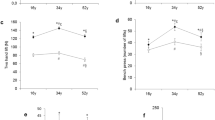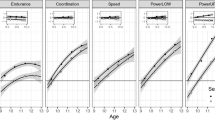Abstract
Health in adulthood is in part a consequence of development and growth taking place during sensitive periods in early life. It has not been explored previously whether early growth is associated with physical performance in old age from a life course perspective taking into account health-related behavior, biological risk factors, and early life experiences. At a mean age of 71 years, physical performance was assessed using the Senior Fitness Test (SFT) in 1078 individuals belonging to the Helsinki Birth Cohort Study. We used multiple linear regression analysis to assess the association between the SFT physical fitness scores and individual life course measurements. Several adult characteristics were associated with physical performance including socioeconomic status, lifestyle factors, and adult anthropometry. Higher birth weight and length were associated with better physical performance, even after adjusting for potential confounders (all p values <0.05). The strongest individual association between life course measurements and physical performance in old age was found for adult body fat percentage. However, prenatal growth was independently associated with physical performance seven decades later. These findings suggest that physical performance in old age is at least partly programmed in early life.

Similar content being viewed by others
References
Barker DJP, Winter PD, Osmond C, Margetts B, Simmonds SJ (1989) Weight in infancy and death from ischaemic heart disease. Lancet 2:577–580
Barker DJ, Hales CN, Fall CH, Osmond C, Phipps K, Clark PM (1993) Type 2 (non-insulin-dependent) diabetes mellitus, hypertension and hyperlipidaemia (syndrome X): relation to reduced fetal growth. Diabetologia 36:62–67
Barker DJ, Osmond C, Forsén TJ, Kajantie E, Eriksson JG (2005) Trajectories of growth among children who have coronary events as adults. N Engl J Med 353:1802–1809
Bedogni G, Malavolti M, Severi S et al (2002) Accuracy of an eight-point tactile-electrode impedance method in the assessment of total body water. Eur J Clin Nutr 56:1143–1148
Ben-Shlomo Y, Kuh D (2002) A life course approach to chronic disease epidemiology: conceptual models, empirical challenges and interdisciplinary perspectives. Int J Epidemiol 31:285–293
Bray GA (2004) Medical consequences of obesity. J Clin Endocrinol Metab 89:2583–2589
Buchan DS, Thomas NE, Baker JS (2012) Novel risk factors of cardiovascular disease and their associations between obesity, physical activity and physical fitness. J Public Health Res 1:59–66
Cooper R, Kuh D, Hardy R, Cooper R, Kuh D, Hardy R, Mortality Review Group (2010) Objectively measured physical capability levels and mortality: systematic review and meta-analysis. BMJ 341:c4467
Dodds R, Denison HJ, Ntani G, Cooper R, Cooper C, Sayer AA, Baird J (2012) Birth weight and muscle strength: a systematic review and metaanalysis. J Nutr Health Aging 16(7):609–615
Eriksson JG, Osmond C, Kajantie E, Forsén TJ, Barker DJ (2006) Patterns of growth among children who later develop type 2 diabetes or its risk factors. Diabetologia 49:2853–2858
Guralnik JM, Ferrucci L, Simonsick EM et al (1995) Lower-extremity function in persons over the age of 70 years as a predictor of subsequent disability. N Engl J Med 332:556–561
Guralnik JM, Fried LP, Salive ME (1996) Disability as a public health outcome in the aging population. Annu Rev Public Health 17:25–46
Hanson MA, Gluckman PD (2014) Early developmental conditioning of later health and disease: physiology or pathophysiology? Physiol Rev 94:1027–1076
Kuh D, Hardy R, Butterworth S, Okell L, Richards M, Wadsworth M, Cooper C, Sayer AA (2006) Developmental origins of midlife physical performance: evidence from a British birth cohort. Am J Epidemiol 164:110–121
Legrand D, Vaes B, Matheï C, Adriaensen W, Van Pottelbergh G, Degryse JM (2014) Muscle strength and physical performance as predictors of mortality, hospitalization, and disability in the oldest old. J Am Geriatr Soc 62:1030–1038
Osmond C, Kajantie E, Forsén TJ, Eriksson JG, Barker DJ (2007) Infant growth and stroke in adult life: the Helsinki birth cohort study. Stroke 38:264–270
Power C, Kuh D, Morton S (2013) From developmental origins of adult disease to life course research on adult disease and aging: insights from birth cohort studies. Annu Rev Public Health 34:7–28
Räikkönen K, Pesonen AK, Kajantie E, Heinonen K, Forsén T, Phillips DI, Osmond C, Barker DJ, Eriksson JG (2007) Length of gestation and depressive symptoms at age 60 years. Br J Psychiatry 190:469–474
Rantanen T, Guralnik JM, Foley D, Masaki K, Leveille S, David Curb J, White L (1999) Mid-life hand grip strength as a predictor of old age disability. JAMA - J Am Med Assoc 286:558–560
Rantanen T, Guralnik JM, Ferrucci L, Penninx BWJH, Leveille SG, Sipilä S, Fried LP (2001) Coimpairments as predictors of severe walking disability in older women. J Am Geriatr Soc 49:21–27
Rich-Edwards JW, Colditz GA, Stampfer MJ, Willett WC, Gillman MW, Hennekens CH, Speizer FE, Manson JE (1999) Birthweight and the risk for type 2 diabetes mellitus in adult women. Ann Intern Med 130(4 Pt 1):278–284
Rikli RE, Jones CJ (1999) Development and validation of a functional fitness test for community-residing older adults. JAPA 6:127–159
Rikli RE, Jones CJ (2013) Development and validation of criterion-referenced clinically relevant fitness standards for maintaining physical independence in later years. Gerontologist 53:255–267
Rikli RE, Jones CJ. Senior Fitness Test Manual 2nd ed. 2013 Champaign, IL. Human Kinetics
Stewart R, Hardy R, Richards M (2015) Associations between skeletal growth in childhood and cognitive function in mid-life in a 53-year prospective birth cohort study. PLoS One 10(4), e0124163
Studenski S, Perera S, Patel K, Rosano C, Faulkner K, Inzitari M et al (2011) Gait speed and survival in older adults. JAMA 305:50–58
Tu YK, Tilling K, Sterne JA, Gilthorpe MS (2013) A critical evaluation of statistical approaches to examining the role of growth trajectories in the developmental origins of health and disease. Int J Epidemiol 42:1327–1339
von Bonsdorff MB, Rantanen T, Laukkanen P et al (2006) Mobility limitations and cognitive deficits as predictors of institutionalization among community-dwelling older people. Gerontology 52:359–365
von Bonsdorff MB, Rantanen T, Sipilä S, Salonen MK, Kajantie E, Osmond C, Barker DJ, Eriksson JG (2011) Birth size and childhood growth as determinants of physical functioning in older age: the Helsinki Birth Cohort Study. Am J Epidemiol 174:1336–1344
von Bonsdorff MB, Törmäkangas T, Rantanen T, Salonen MK, Osmond C, Kajantie E, Eriksson JG (2015) Early life body mass trajectories and mortality in older age: findings from the Helsinki Birth Cohort Study. Ann Med 47:34–39
Wallman T, Wedel H, Johansson S, Rosengren A, Eriksson H, Welin L, Svärdsudd K (2006) The prognosis for individuals on disability retirement. An 18-year mortality follow-up study of 6887 men and women sampled from the general population. BMC Public Health 6:103
Wilkin LD, Haddock BL (2010) Health-related variables and functional fitness among older adults. Int J Aging Hum Dev 70(2):107–185
World Health Organization (2011) Global health and ageing. World Health Organization
Ylihärsilä H, Kajantie E, Osmond C, Forsén T, Barker DJ, Eriksson JG (2007) Birth size, adult body composition and muscle strength in later life. Int J Obes 31(9):1392–1399
Ylihärsilä H, Kajantie E, Osmond C, Forsén T, Barker DJ, Eriksson JG (2008) Body mass index during childhood and adult body composition in men and women aged 56–70 y. Am J Clin Nutr 87(6):1769–1775
Author information
Authors and Affiliations
Corresponding author
Ethics declarations
Funding
HBCS has been supported by grants from Finska Läkaresällskapet, the Finnish Special Governmental Subsidy for Health Sciences, Academy of Finland, Samfundet Folkhälsan, Liv och Hälsa, the Signe and Ane Gyllenberg Foundation, and EU FP7 (DORIAN) project number 278603. MBvB was supported by the Academy of Finland grant no. 257239. EU H2020-PHC-2014-DynaHealth, Grant no. 633595.
Electronic supplementary material
Below is the link to the electronic supplementary material.
ESM 1
(DOCX 70.4 kb)
About this article
Cite this article
Eriksson, J.G., Osmond, C., Perälä, MM. et al. Prenatal and childhood growth and physical performance in old age—findings from the Helsinki Birth Cohort Study 1934–1944. AGE 37, 108 (2015). https://doi.org/10.1007/s11357-015-9846-1
Received:
Accepted:
Published:
DOI: https://doi.org/10.1007/s11357-015-9846-1




